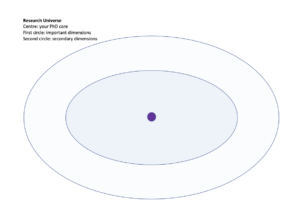Practicing, writing and sharing your work are strong interrelated pillars of the doctoral process. Developing skills in synthesis and integrating the different forms / threads of your doctoral project is a key part of your learning. This takes place throughout the degree and in particular, during the writing up stage, as you present your contribution to the field in an organised and concise manner.
As you shift between writing, practicing and showing, you will refine the dimensions or lines of inquiry that are relevant to explore further. As this student says, ‘I learnt something about my participants’ experience in each [performance] that then fed into the design for the next. So it became a very iterative process’ (PhD student). Synthesising and integrating advances the research, as you navigate between distinct spheres of activity.
Speaking of the articulation between practice and writing:
One of the challenges of the artistic doctorate lies precisely in finding and articulating the argument that underlies the various areas of practice. You will do this through exploring, selecting and investigating the various dimensions that you come across in your research. it is helpful to think of all this work as a single thesis which asks the same question in different forms as Vida Midgelow proposes.
Your articulation between practicing, writing and showing work will also be apparent in your final submission. The balance between written and practical components is often indicated in the regulations of your programme and may also be negotiated with your supervisory team. This can range between a short 20.000 words commentary on the practice and a 50–60.000 words analytical piece of writing. In this short excerpt, Annette Arlander speaks about the tensions around the balance between artistic and written outcomes in the doctoral submission, as well as the role of the writing.
Proposals for Action: Research Universe
Handling large amounts of materials – visual, written, spoken – can be overwhelming and often places the researcher in a paralysis of not knowing where to go next. This short reflective exercise will help you find some clarity.
Start by listing all the possibilities you could act upon / develop further / expand / research. you will likely come up with a list of different directions your project could take, or of important keywords. Next, look at the Research Universe, and bring your research question or area of inquiry into mind. Pick one item at a time from your list and reflect on its importance for your research question: if it is very important, place it in the inner circle, close to the centre of the page, which represents the core of your PhD. You can write the whole sentence, or a keyword, or give each item a number. If you feel it is not so important, place it in the second circle, further away from your PhD core. Continue working through your list until you finish. You should now have a selection of dimensions which are more relevant for your research. You can repeat this exercise as often as needed – and things may change as the research progresses – and for different parts of your project, such as the literature review, directions in your practice, or ideas you are exploring for a chapter.

ADR-Synthesis-Integration.pdf
€0,00Add to downloads
